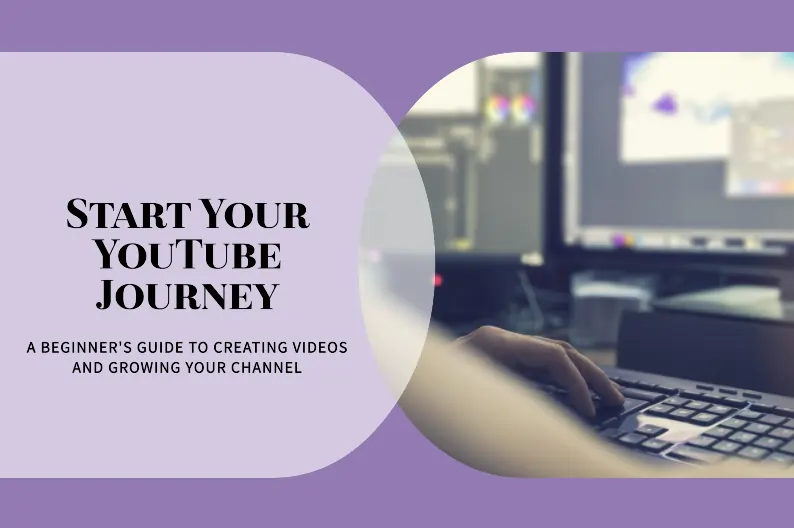Get Started on YouTube: A Beginner’s Guide to Creating Videos and Growing Your Channel

Welcome to the exciting world of YouTube! YouTube has become a significant platform for sharing and consuming content. It’s not just a platform to watch funny cat videos; it’s a place to learn, to share experiences, and even make a living. Whether you’re an aspiring filmmaker, a passionate hobbyist, or a business owner looking to expand your reach, YouTube offers endless possibilities. So, let’s dive right in!
Introduction
Why YouTube?
YouTube is the second most visited website in the world, with over 2 billion logged-in users per month. On average, people watch over a billion hours of video on YouTube every day, making it an excellent platform for reaching a wide audience. Furthermore, YouTube videos are easy to share on social media and embed on websites, making them a powerful tool for spreading your message.
The journey of a successful YouTuber
Being a successful YouTuber isn’t about overnight fame. It involves consistent effort, strategic planning, and most importantly, creating engaging content that resonates with viewers. The journey begins with understanding the platform, finding your niche, and gradually building your channel. Along the way, you’ll learn how to enhance your videos, grow your viewer base, navigate YouTube Shorts, and understand YouTube monetization.
Getting Started on YouTube
Creating your YouTube account
To start, you’ll need a Google account. If you don’t already have one, head over to the Google sign-up page and fill out the necessary information. Once your Google account is ready, navigate to YouTube and click on ‘Sign In’ in the top right corner. Enter your Google account details, and voila! You now have a YouTube account.
Understanding the YouTube interface
YouTube’s interface is user-friendly and intuitive. The Home page displays videos customized to your preferences. On the left side, you’ll find a navigation bar with various sections like Trending, Subscriptions, Library, and History. The top right corner houses notifications, settings, and your profile picture, which leads to more options like YouTube Studio where you can manage your channel and analytics.
Setting up your YouTube channel
Click on your profile picture, select ‘Your Channel,’ then click on ‘Create Channel.’ Here, you can name your channel and write a description to tell viewers what they can expect from your content. Remember, this information is crucial as it helps viewers decide whether or not to subscribe. You can also add links to your social media accounts and a channel banner for extra personalization.
Becoming a Content Creator
Deciding on your niche
Your niche is the specific topic area that your videos will focus on. It could be anything from cooking tutorials to video game reviews. When choosing your niche, consider your interests and expertise. Also, think about who your target audience is, and what kind of content they would find valuable.
Planning your content
Successful YouTubers plan their content strategically. Make a list of video ideas, and create a content schedule. This not only helps you stay consistent but also keeps your audience engaged. Remember, quality trumps quantity. It’s better to post one well-made video a week than several low-quality ones.
Shooting your first video
Don’t worry if you don’t have fancy equipment; many successful YouTubers started with just their smartphones. The key is to ensure good lighting and clear audio. Write a script to keep your video focused, and rehearse before filming to reduce the number of takes. Don’t forget to introduce yourself and explain the purpose of the video at the beginning.
If you don’t want to be on camera you can create Ai generated videos with tools such as Pictory, Invideo, and Wave. There are many highly profitable faceless channels out there being created this way with these AI video tools.
Another tool that’s growing in popularity quickly for automated faceless videos, and comes with training, is Shinefy. You can get the yearly subscription at a substantial savings here.
Enhancing Your Videos
Basic video editing techniques
Editing is where the magic happens. You can remove mistakes, add effects, and make your video more engaging. There are many free and paid video editing software options available. Start with basic techniques like cutting unnecessary footage, adding transitions, and correcting color and sound. As you gain confidence, explore more advanced techniques, or again, let AI do the work with the tools mentioned before.
Adding music and sound effects
Music and sound effects can greatly enhance your videos. They can set the mood and emphasize key points. However, be careful about copyright issues. Use royalty-free music or purchase licenses for commercial music. YouTube also provides a library of free music and sound effects. Pictory, Invideo, and Wave all come with royalty free music that can be added to the AI generated videos.
Using annotations, cards, and end screens
Annotations, cards, and end screens are tools that help promote your content, drive engagement, and guide viewers through your videos. Annotations are clickable text overlays, cards can contain more detailed information or links, and end screens can be used to promote other videos, playlists or your website and to encourage subscriptions. These you can setup in your YouTube studio for each video you make.
Growing Your Channel
Optimizing your videos for search
YouTube is the second largest search engine, so optimizing your videos for search is crucial. Use keywords in your video title, description, and tags. Make sure they are relevant to your content and what users are likely to search for. You can start with the free versions of VidIQ or Tubebuddy, both or which are the leaders in helping you use the right titles and keywords to rank on yourtube, and to comer up with ideas of content to make that people are looking for. Don’t skip this as if no one finds your video, your channels going nowhere!
Also, make sure to upload a custom thumbnail that accurately represents your video and catches the viewer’s eye. It doesn’t matter how great your video is, if your thumbnail sucks and no one clicks it, it’s a wasted effort, so don’t skip this step either. You can use programs like Canva or the lower cost Vista Create as an alternative for this, but the free account is likely all you’ll need.
Promoting your channel
Don’t just rely on YouTube’s algorithm to get views. Promote your videos on social media, your website, or even email newsletters. Collaborate with other YouTubers to reach new audiences. And always encourage viewers to like, share, and subscribe at the end of each video.
You can use tools like Ocoya and Radaar to automate and schedule Social media postings to drive viewers to your videos and offers.Engaging with your viewers
Engagement is key to building a loyal audience. Respond to comments, ask for feedback, and create a community around your channel. You can also host live chats during premieres or Q&A sessions to interact directly with your viewers.
Navigating YouTube Shorts
Understanding what YouTube Shorts are
YouTube Shorts are short-form videos, 60 seconds or less, designed for mobile viewing. They are YouTube’s answer to the rising popularity of TikTok. Shorts appear on the YouTube homepage and on the Shorts shelf on the YouTube app, offering a new way to reach viewers.
How to create and upload YouTube Shorts
To create a Short, you can use the YouTube app’s Shorts camera, which offers tools like speed controls and a timer. If you’re uploading a pre-made video, make sure it’s vertical, not more than 60 seconds, and includes ‘#Shorts’ in the title or description. You upload Shorts just like regular videos, through the ‘Create’ button.
Increasing visibility through YouTube Shorts
Shorts can be a great way to reach new audiences and increase your channel’s visibility. Since they are short and easy to consume, viewers are more likely to watch them to the end, boosting your engagement rates. Be sure to use relevant hashtags to increase the chances of your Shorts being discovered.
Understanding YouTube Monetization
How to monetize your YouTube Channel
To start earning money from your YouTube channel, you need to join the YouTube Partner Program. The requirements were reduced in 2023, with now only needing 500 subscribers, 3,000 watch hours in the previous 12 months, or 3 Million Valid Public Shorts Views in 90 Days, and an AdSense account. Once approved, you can earn money from ads, channel memberships, merchandise shelf, and YouTube Premium revenue.
Understanding YouTube’s Ad Revenue Share
YouTube shares ad revenue with creators. When an advertiser pays YouTube for an ad, 55% goes to the creator and 45% to YouTube. The actual earnings depend on various factors such as the number of views, the number of clicks on ads, and the ad type.
Exploring other monetization options
Besides ads, there are several other ways to monetize your YouTube channel. These include channel memberships, where viewers pay a monthly fee for exclusive perks; Super Chat and Super Stickers, where viewers can pay to have their messages highlighted during live chat; and the merchandise shelf, where you can showcase your official merchandise right below your video. Let’s not forget affiliate marketing, which is one of the best ways to earn from your channel from the start as there’s no subscriber and watch time requirements for this.
Conclusion
Key takeaways
Starting a YouTube channel is an exciting journey that requires careful planning and consistent effort. Understand the platform, decide on your niche, create engaging content, and use tools like annotations, cards, and end screens to enhance your videos. Grow your channel by optimizing your videos for search, promoting your channel, and engaging with your viewers. Explore new opportunities with YouTube Shorts and learn how to monetize your channel effectively.
Encouragement for your YouTube journey
Remember, every successful YouTuber started from zero. Don’t be discouraged if growth seems slow initially. Stay consistent, keep improving, and most importantly, enjoy the process. Your passion will shine through in your videos, and viewers will be drawn to your authenticity. Good luck on your YouTube journey!
Questions? We Have Answers.
Get answers to a list of the most Frequently Asked Questions.






